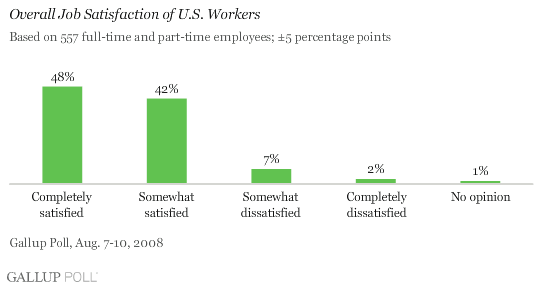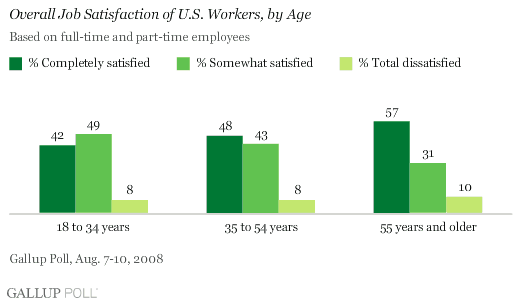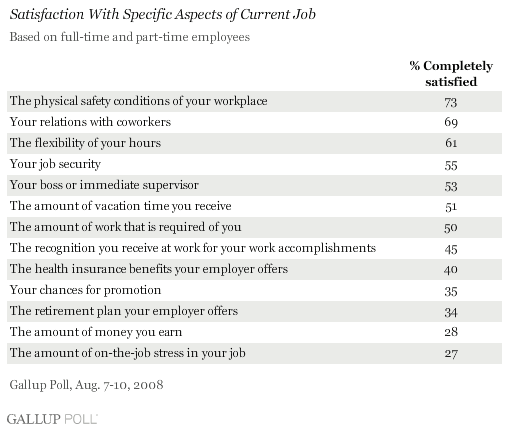PRINCETON, NJ -- At a time when Americans' ratings of the country and of the nation's economy are near record lows, the percentage of U.S. workers feeling "completely satisfied" with their jobs -- now 48% -- is at the high end of the range seen in the past eight years.

Another 42% of part-time and full-time workers in the United States say they are "somewhat satisfied," resulting in most workers' being generally upbeat about their employment. Only 9% are dissatisfied to any degree.

This year's Gallup Poll Social Series Work and Education poll, conducted Aug. 7-10, shows little difference between men and women, and even between upper- and middle-income workers, in overall job satisfaction. The more notable differences are by age, with the oldest category of workers (aged 55 and older) much more likely to be "completely satisfied" than are those still building their careers (18 to 34): 57% vs. 42%.

Coworkers and Flex Time Are Bright Spots
The work environment encompasses numerous workload, interpersonal, financial, and other dimensions, and as the Gallup workplace survey shows, not all of these receive equally favorable reviews from American workers.
On the positive side, large proportions of Americans who are employed either part-time or full-time say they are completely satisfied with the physical safety conditions where they work (73%), with their relations with coworkers (69%), and with the flexibility of their hours (61%). Solid majorities are also completely satisfied with their job security (55%) and their bosses or supervisors (53%).
Only about half of workers are completely satisfied with the amount of vacation time they receive (51%), the amount of work required of them (50%), and the recognition they receive at work for their accomplishments (45%).
Aspects of their jobs that large majorities of workers feel could be better include on-the-job stress (only 27% are completely satisfied), pay (28%), company-sponsored retirement plans (34%), chances for promotion (35%), and health insurance benefits (40%).

Worker satisfaction is down today compared with August 2007 on some of these items, but last year's higher ratings were generally the anomaly in Gallup's annual measures since 2001. The current percentage of workers satisfied on most employment dimensions is similar to the average ratings found over the past eight years.
Permanent Pay Gripes
While employers may see some benefit in striving to improve employee satisfaction where it lags the most, at least in terms of pay, achieving high satisfaction may never be possible. A separate Gallup question finds a roughly equal split between workers who consider themselves "underpaid" versus "paid about the right amount" for the work they do, 51% vs. 46%. Yet not even half of those who say they are paid the right amount also say they are completely satisfied with the money they earn (48%).

Bottom Line
Worker satisfaction is refreshingly positive to see amid otherwise gloomy public attitudes about the country. To some extent, this may reflect a heightened appreciation on the part of some workers for having a job at a time when they realize good jobs are hard to come by, and when being out of work is no picnic. (It also reflects the basic reality that dissatisfied workers -- like unhappy spouses -- don't stay put for long, so the percentage of workers who are dissatisfied should never be overly high.)
Although workers clearly think their pay, benefits, promotion opportunities, and stress could all be better, generally high satisfaction with their coworkers and boss, flexibility in their hours, and job security seem to largely offset those negatives.
Survey Methods
Results are based on telephone interviews with 1,009 national adults, aged 18 and older, conducted Aug. 7-10, 2008. For results based on the total sample of national adults, one can say with 95% confidence that the maximum margin of sampling error is ±3 percentage points.
For results based on the sample of 557 adults employed full or part-time, the maximum margin of sampling error is ±5 percentage points.
Interviews are conducted with respondents on land-line telephones (for respondents with a land-line telephone) and cellular phones (for respondents who are cell-phone only).
In addition to sampling error, question wording and practical difficulties in conducting surveys can introduce error or bias into the findings of public opinion polls.
To provide feedback or suggestions about how to improve Gallup.com, please e-mail feedback@gallup.com.
